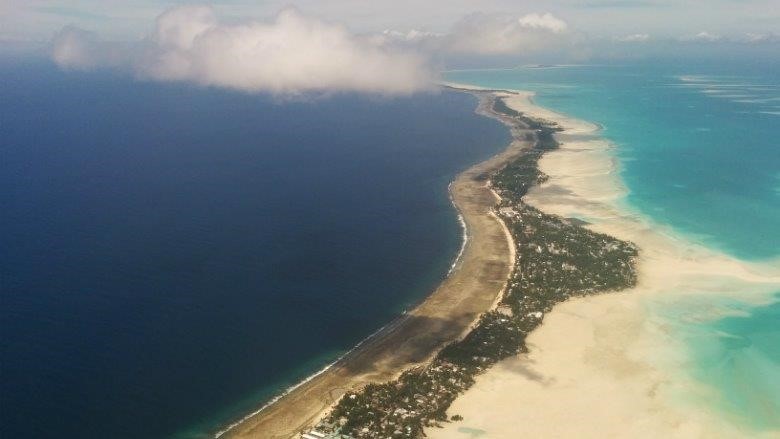Australia is committed to helping the people of Kiribati meet the challenges of climate change.
At the 2016 Pacific Islands Forum, Prime Minister Turnbull announced a climate change and resilience support package to the Pacific of $300 million over four years. This is part of Australia's $1 billion, five-year climate finance pledge made at the 2015 Paris climate change meeting.
To take action on climate change Australia's focus is on climate research and information, building resilience to climate change and disasters, and increasing country capacity to respond to disaster events. This support aligns with the Framework for Regional Development in the Pacific, endorsed by Pacific Island Forum leaders, which outlines an integrated approach to addressing climate change and disaster resilience. Australia also works to support Kiribati's commitments under its Nationally Determined Contribution to the UN Framework Convention on Climate Change.
Key risks and challenges
Kiribati is internationally recognised as one of the world's most vulnerable countries. Its 33 islands, spread across 3.5 million km2 of ocean, have a combined land area of just 811 km2. With most land at less than 2 m above sea level and the atolls averaging less than 500 m in width, Kiribati is highly vulnerable to sea storms and high tides. There is already evidence of increased sea flooding and incremental salinisation of fresh water aquifers.
The impacts of climate change on Kiribati's fresh water supplies, coastal infrastructure and agricultural land, reefs and fisheries, as well as on people's health and livelihoods, are projected to worsen over time and compound pressures already experienced across the island groups, particularly in South Tarawa.
Opportunities
Despite these risks and vulnerabilities, opportunities exist in Kiribati to build resilience by addressing current pressing development issues including water, food and energy security; sanitation; resilient housing, schools and health facilities; and long terms skills and labour market development.
There is an urgent need for sound, evidence-based coastal development policies to maintain/restore coastal defences and protect critical infrastructure.
There is also an urgent need for investment in renewable energy (solar), to provide affordable electricity and substantial co-benefits for community and economic resilience.
National development policies with a core focus on climate change provide a solid basis for enhanced action and for integrating climate change risks and resilience into core sectors.
Ensuring social infrastructure is climate resilient
Through the Kiribati Education Improvement Program ($70 million 2011-19), Australia is helping to design and construct school facilities that take account of sea flooding and water shortages. Both challenges are projected to worsen as climate change impacts escalate over time.
Making sure educational infrastructure is resilient to these impacts will help reduce the barriers to education in Kiribati.
Bilateral programs
Australia will provide an estimated $11.9 million in climate change support to Kiribati from 2015-16 to 2017-18.
Our support includes the construction of resilient infrastructure and facilities under the Kiribati Education Improvement Program, Kiribati Road Rehabilitation Project ($68 million 2013-19) – and increasing coastal resilience by building shoreline protection works at priority sites on South Tarawa under the Kiribati Adaptation Project (KAP) Phase III ($5.8 million 2010-2018).
The Kiribati Skills for Employment Program ($20 million 2016-20) is investing in the long-term resilience of young i-Kiribati by providing skills' development and access to international labour markets.
The current Australian Aid Investment Plan (2015‑16 to 2018-19) includes a commitment to building resilience to the impacts of climate change by supporting the Government of Kiribati to address pressing economic and social development challenges, resilient infrastructure and facilities, service delivery, skills and labour mobility, and through support for the national flagship climate change program (KAP III).
These sectors will remain key areas for integrating climate change into Australian assistance in future.
Regional programs
Kiribati benefits from Australia's regional climate change programs, which total over $50 million (2015-16 to 2017-18).
Our programs work to:
- Build capacity of national meteorology services and measure sea level rise through the Climate and Oceans Support Program in the Pacific
- Improve access to and use of climate information for decision making and knowledge management through the iCLIM program
- Support the capacity of Pacific island countries, including Kiribati, to access climate finance, through the German development organisation GIZ, and
- Provide technical support to integrate climate change across our programs.
Australia also provides support to the Pacific Regional Environment Programme whose mandate includes addressing priority climate change issues.
These programs build on our long-term support for climate science in the Pacific.
Global programs
Kiribati further benefits from Australian global humanitarian and disaster risk reduction programs. Australia has committed $5 million to the global Climate Risk and Early Warning Systems which runs a project to strengthen the Regional Specialised Meteorological Centre to provide services to all Pacific island countries.
Australia also contributes to global climate finance mechanisms, including the Green Climate Fund ($200 million committed over four years from 2015) and the Global Environment Facility ($93 million committed, 2014-15 to 2017-18).
These funds support a wide range of resilience building and emissions reduction projects in the Pacific region. Australia uses its seat on the Green Climate Fund Board and the Global Environment Facility Council to streamline processes, highlight the climate change challenges and vulnerability of Pacific island countries and advocate Pacific focused proposals.

